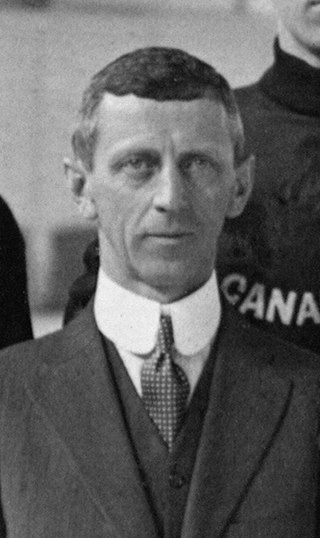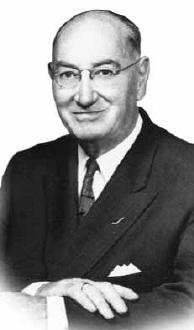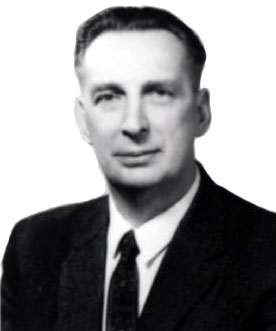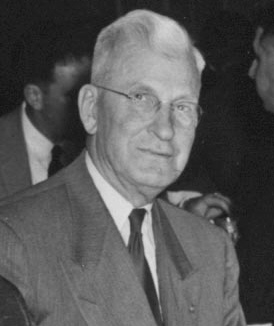Related Research Articles
The men's ice hockey tournament at the 1948 Winter Olympics in St. Moritz, Switzerland, was the sixth Olympic Championship, also served as the 15th World Championships and the 26th European Championships. Canada won its fifth Olympic gold medal and 12th World Championship, represented by the Ottawa RCAF Flyers team of Canadian Armed Forces personnel. The highest-finishing European team Czechoslovakia, won the silver medal and its eighth European Championship. Bibi Torriani played for Switzerland which won the bronze medal, and became the first ice hockey player to recite the Olympic Oath on behalf of all athletes.

USA Hockey is the national ice hockey organization in the United States. It is recognized by the International Olympic Committee and the United States Olympic & Paralympic Committee as the governing body for organized ice hockey in the United States and is a member of the International Ice Hockey Federation. Before June 1991, the organization was known as the Amateur Hockey Association of the United States (AHAUS).

William Abraham Hewitt was a Canadian sports executive and journalist, also widely known as Billy Hewitt. He was secretary of the Ontario Hockey Association (OHA) from 1903 to 1966, and sports editor of the Toronto Daily Star from 1900 to 1931. He promoted the establishment of the Canadian Amateur Hockey Association (CAHA), then served as its secretary-treasurer from 1915 to 1919, registrar from 1921 to 1925, registrar-treasurer from 1925 to 1961, and a trustee of the Allan Cup and Memorial Cup. Hewitt standardized player registrations in Canada, was a committee member to discuss professional-amateur agreements with the National Hockey League, and negotiated working agreements with amateur hockey governing bodies in the United States. He oversaw referees within the OHA, and negotiated common rules of play for amateur and professional leagues as chairman of the CAHA rules committee. After retiring from journalism, he was the managing-director of Maple Leaf Gardens from 1931 to 1948, and chairman of the committee to select the inaugural members of the Hockey Hall of Fame in 1945.

George Samuel Dudley was a Canadian ice hockey administrator. He joined the Ontario Hockey Association (OHA) executive in 1928, served as its president from 1934 to 1936, and as its treasurer from 1936 to 1960. He was elected to Canadian Amateur Hockey Association (CAHA) executive in 1936, served as its president from 1940 to 1942, as its secretary from 1945 to 1947, and as its secretary-manager from 1947 to 1960. He was secretary of the International Ice Hockey Association from 1945 to 1947, and was later vice-president of the International Ice Hockey Federation (IIHF) from 1957 to 1960. He was expected to become the next president of the IIHF before his death. He graduated from Osgoode Hall Law School in 1917 then practiced law for 43 years as the town solicitor for Midland, Ontario.

Allan Wilfrid Pickard was a Canadian ice hockey administrator, who served as president of the Canadian Amateur Hockey Association (CAHA) from 1947 to 1950. When Canada opted out of the 1947 Ice Hockey World Championships and decided not to participate in the 1948 Winter Olympics, Pickard felt that Canada was obliged to send a team due to its place as a top hockey nation, and nominated the Ottawa RCAF Flyers who won the gold medal for Canada and lived up to the requirements of the Olympic Oath as amateurs. Despite disagreement with the International Olympic Committee, he sought for the International Ice Hockey Federation to adopt the CAHA definition of amateur in the face of increasing difficulty in selecting the Canada men's national ice hockey team.
Thomas Finan Lockhart was an American ice hockey administrator, business manager, and events promoter. He was president of the Eastern Hockey League from 1933 to 1972, and was the founding president of the Amateur Hockey Association of the United States (AHAUS) in 1937, which later became USA Hockey. He led AHAUS into the International Ice Hockey Association in 1940, then into the Ligue Internationale de Hockey sur Glace in 1947. He managed operations at Old Madison Square Garden, introduced fans to innovative on-ice promotions which made amateur hockey a profitable event. He was the business manager of the New York Rangers for six years, and was inducted into both the Hockey Hall of Fame and the United States Hockey Hall of Fame, and is a recipient of the Lester Patrick Trophy for building the game in the United States.

Frederick Page was a Canadian ice hockey administrator and ice hockey referee. He originated from Port Arthur, Ontario, where he played junior ice hockey, refereed locally and later at the Memorial Cup and Allan Cup competitions. He was a league executive in Fort William, then served as president of the Thunder Bay Amateur Hockey Association from 1958 to 1962. He was elected second vice president of the Canadian Amateur Hockey Association (CAHA) in 1962, and rose up the ranks to be its president from 1966 to 1968. Page wanted the CAHA to gain more control over its affairs, and become less dependent on the National Hockey League (NHL). Under his leadership, the NHL ended direct sponsorship of junior hockey teams. He was instrumental in negotiating the revised agreement for the NHL Amateur Draft in 1967, and later served as co-chairman of the resulting joint player development committee.
The 1947 Ice Hockey World Championships were the 14th World Championships and 25th European Championship was the first after the Second World War. It was held from 15 to 23 February 1947 at Štvanice Stadium in Prague, Czechoslovakia. Eight teams participated, but the competition was notably missing the reigning world champion, Canada. The world champion was decided for the first time by round robin league play. Czechoslovakia won the world championship for the first time and the European championship for the seventh time. King Gustav V had sent a telegram of congratulations to the Swedish team after beating the Czechoslovaks, but they had barely finished celebrating when they were upset by the Austrians, costing them the gold medal.

Hanson Taylor Dowell was a Canadian ice hockey administrator and politician. He served as president of the Canadian Amateur Hockey Association from 1945 to 1947, and was the first person from the Maritimes to serve on the national executive. He sought to have the Canadian definition of amateur recognized at the World Championships and the Olympic Games for the benefit of Canada's national team, and negotiated the merger of the International Ice Hockey Association into the Ligue Internationale de Hockey sur Glace. He served as president of the Maritime Amateur Hockey Association from 1936 to 1940, and later as treasurer of the Maritimes and the Nova Scotia Hockey Associations for a combined 30 years.

The Alexander Cup was the championship trophy for the Major Series of senior ice hockey in the Canadian Amateur Hockey Association from 1950 to 1954. The trophy was presented by its namesake, the Viscount Alexander as the 17th Governor General of Canada.

William George Hardy was a Canadian professor, writer, and ice hockey administrator. He lectured on the Classics at the University of Alberta from 1922 to 1964, and served as president of the Canadian Authors Association. He was an administrator of Canadian and international ice hockey, and served as president of the Alberta Amateur Hockey Association, the Canadian Amateur Hockey Association (CAHA), the International Ice Hockey Association, and the International Ice Hockey Federation.

William Alexander Fry was a Canadian sports administrator and newspaper publisher. Fry founded the Dunnville Chronicle in 1896, managed local hockey and baseball teams in the 1910s, then served as president of the Ontario Hockey Association (OHA) from 1922 to 1924. At the national level, he was president of the Canadian Amateur Hockey Association (CAHA) from 1928 to 1930, was a Canadian Olympic Committee member and British Empire Games committee member from 1927 to 1938, and served as president of the Amateur Athletic Union of Canada from 1934 to 1936.

Frank Forest Sargent was a Canadian sports executive in ice hockey and curling. He served as president of the Canadian Amateur Hockey Association (CAHA) from 1942 to 1945, and was president of the Dominion Curling Association (DCA) from 1965 to 1966. He was the first person to be elected to more than two terms as CAHA president, and the first to be president of two national amateur sporting associations in Canada.

Cecil Charles Duncan was a Canadian ice hockey administrator. He served as president of the Canadian Amateur Hockey Association (CAHA) from 1936 to 1938 and led reforms towards semi-professionalism in ice hockey in Canada. He served as chairman of the CAHA committee which proposed a new definition of amateur to eliminate what it called "shamateurism", in the wake of Canada's struggles in ice hockey at the 1936 Winter Olympics. He negotiated a series of agreements to protect the CAHA's interests, and to develop relationships with all other areas of the world where hockey was played. The agreements allowed the CAHA to become independent of the Amateur Athletic Union of Canada which wanted to keep the old definition of pure amateurism. Duncan's reforms also returned the CAHA to affluence after four years of deficits during the Great Depression and increased player registrations in Canada.

John Welch Hamilton was a Canadian sports executive. He served as president of the Canadian Amateur Hockey Association (CAHA) from 1930 to 1932, president of the Amateur Athletic Union of Canada from 1936 to 1938, and was a member of the Canadian Olympic Committee for 17 years. His leadership of the CAHA and the AAU of C coincided with efforts to maintain amateurism and combat growing professionalism in sport. He appointed a committee to establish better relations between the CAHA and professional leagues, and praised the players and teams for quality hockey and growth of the amateur game in Canada despite the competition. He favoured professionals in one sport playing as amateurs in another, and took charge of the AAU of C at a time when the CAHA, the Canadian Amateur Basketball Association, and the Canadian Amateur Lacrosse Association challenged the definition of amateur, and later broke away from the AAU of C which wanted to hold onto purist ideals of amateurism.

Frank Ernest Sandercock was a Canadian ice hockey administrator. He served as president of both the Canadian Amateur Hockey Association and the Alberta Amateur Hockey Association, and had previously been an executive with the Ontario Hockey Association and founded a hockey organization to operate leagues in Calgary. He was an early proponent of junior ice hockey and senior ice hockey in Alberta, fostered growth in the game, and sought to reinvest profits into minor ice hockey for the younger generation.

Edward Albert Gilroy was a Canadian ice hockey administrator. He served as president of the Manitoba Amateur Hockey Association (MAHA) from 1927 to 1934, and the Canadian Amateur Hockey Association (CAHA) from 1934 to 1936. In Manitoba, he sought to expand senior ice hockey and establish co-operation between teams and owners of the Winnipeg Amphitheatre on schedules and reducing travel costs. He wanted all players aged 21 and younger to remain in junior ice hockey and began to negotiate with professional teams to refrain from signing them to contracts. His seven years as leader of the MAHA was the longest tenure for a president at the time, during which he oversaw continued growth of the association and improvement of finances.

Douglas George Grimston was a Canadian ice hockey administrator who served as president of the Canadian Amateur Hockey Association (CAHA) from 1950 to 1952. He oversaw the establishment of the Major Series for the Alexander Cup and implemented a new deal for player contracts in senior ice hockey, in response to the Allan Cup championship being dominated by a small group of teams who sought to protect themselves from professional leagues recruiting their players. He opposed the National Hockey League wanting its junior ice hockey prospect players on stronger teams, which led to limits on the transfer of players to keep balanced competition for the Memorial Cup. After the 1952 Winter Olympics where the Canada men's national ice hockey team won the gold medal, Grimston recommended withdrawal from Olympic hockey since European nations would never agree to ice hockey rules which allowed physical play. Grimston later accused International Ice Hockey Federation vice-president Bunny Ahearne of financially exploiting of the Edmonton Mercurys on a European tour, which led to a physical altercation between them.

William Bryden George, also known as Baldy George, was a Canadian sports administrator and agriculturalist. He was president of the Canadian Amateur Hockey Association from 1952 to 1955, when Canada debated whether it would withdraw from the Ice Hockey World Championships and the Olympic Games. At issue was the perceived financial exploitation of the Canada men's national ice hockey team and abuse from European media on the Canadian style of physical play. He wanted a financial guarantee for the national team when it travelled since its participation increased attendance at events in Europe. Canada did not participate at the World Championships in 1953 and placed second in 1954, which led to heavy criticism by media in Canada for the failure to win. Although Canada won the 1955 Ice Hockey World Championships, George questioned future participation and was concerned that the game in Europe took on political and religious meanings in which Canada did not want to become involved.

Frederick Paul Henry Marples was a Canadian sports executive in ice hockey and athletics. He was president of the Winnipeg Monarchs team which won Winnipeg Amateur Hockey League championships in 1914 and 1915, and the Allan Cup as senior ice hockey champions of Canada. His operation of a reserve team to support the Monarchs led to debates on player eligibility for the Allan Cup and calls for a national governing body of hockey. As the secretary-treasurer of the Winnipeg Amateur Hockey League, he helped establish both the Manitoba Amateur Hockey Association (MAHA) and the Canadian Amateur Hockey Association (CAHA) in 1914; then served as secretary-treasurer of the MAHA from 1914 to until 1934, and as secretary of the CAHA from 1926 to 1945. He sought to grow the game in rural regions of Manitoba, promote minor ice hockey as a source of future senior players, to keep players in junior ice hockey until age 21, and was against the exodus of amateur players to professional teams.
References
- ↑ Hardy, W. G. (November 1, 1936). "Should We Revise Our Amateur Laws?". Maclean's. Archived from the original on September 20, 2020. Retrieved November 30, 2019.
- ↑ "Pro. Vs. Amateur Games Approved If Exhibition". Winnipeg Tribune. Winnipeg, Manitoba. November 20, 1936. p. 1.
- ↑ "No Concern Felt Here Over Trouble In Eastern Loop". Winnipeg Tribune. Winnipeg, Manitoba. March 2, 1937. p. 13.
- ↑ "Eastern U.S. Puck Loops Quits A.A.U." Winnipeg Tribune. Winnipeg, Manitoba. August 31, 1937. p. 36.
- ↑ "Thomas F. Lockhart". United States Hockey Hall of Fame. Retrieved January 1, 2020.
- ↑ "Lockhart, Thomas -- Honoured Builder". Legends of Hockey. Hockey Hall of Fame. Retrieved January 1, 2020.
- ↑ "Canadian-U.S. Amateur Hockey Pact Is Signed". Lethbridge Herald. Lethbridge, Alberta. September 6, 1938. p. 13.
- ↑ McGeachy, J. B. (February 14, 1939). "Hockey Blow-up Looming". Winnipeg Free Press. Winnipeg, Manitoba. p. 1.
- ↑ "C.A.H.A. Sessions Conclude". Winnipeg Free Press. Winnipeg, Manitoba. April 12, 1939. p. 6.
- ↑ "Hockey Chief In Favor of A.A.U.'s New Definition". Winnipeg Free Press. Winnipeg, Manitoba. November 18, 1938. p. 18.
- 1 2 3 Clarke, Robert (April 16, 1940). "New Controlling Body Formed At C.A.H.A. Meet". Winnipeg Free Press. Winnipeg, Manitoba. p. 15.
- 1 2 "Dr. Hardy Outlines Scheme At Annual Gathering C.A.H.A." Lethbridge Herald. Lethbridge, Alberta. January 4, 1941. p. 18.
- ↑ "Rules, Playdowns Discussed At C.A.H.A. Meeting". Winnipeg Free Press. Winnipeg, Manitoba. January 4, 1941. p. 21.
- ↑ "C.A.H.A. Meeting Ends at Weekend After Completing Major Business". Medicine Hat News. Medicine Hat, Alberta. January 6, 1941. p. 3.
- 1 2 "N.H.L. Will Pay I.H.A. $500 Cash For Signing Up Amateur Players". Lethbridge Herald. Lethbridge, Alberta. September 13, 1940. p. 16.
- ↑ Clarke, Robert (April 16, 1940). "New Controlling Body Formed At C.A.H.A. Meet". Winnipeg Free Press. Winnipeg, Manitoba. p. 15.
- ↑ "Clubs Will Share Reimbursement Under This Plan". Winnipeg Free Press. Winnipeg, Manitoba. October 18, 1940. p. 20.
- ↑ "Notes On Meeting Of A.A.H.A." Lethbridge Herald. Lethbridge, Alberta. November 12, 1940. p. 5.
- 1 2 "Close Co-Operation Exists Between Hockey Organizations". Winnipeg Tribune. Winnipeg, Manitoba. January 2, 1941. p. 12.
- ↑ "Regina Claims Players". Winnipeg Tribune. Winnipeg, Manitoba. October 27, 1941. p. 16.
- ↑ "Hope Announce Lengthy List At Week-End". Lethbridge Herald. Lethbridge, Alberta. November 8, 1941. p. 18.
- ↑ "Amateurs Receive $17,000". Winnipeg Tribune. Winnipeg, Manitoba. April 20, 1942. p. 15.
- ↑ "Young Players For N.H.L. Clubs?". Winnipeg Tribune. Winnipeg, Manitoba. August 22, 1942. p. 19.
- ↑ "$38,000 Profit In Puck Series". Winnipeg Tribune. Winnipeg, Manitoba. April 26, 1943. p. 16.
- ↑ "Halt Concessions To Major League". Winnipeg Tribune. Winnipeg, Manitoba. October 29, 1943. p. 16.
- ↑ "Protest Signing Teen-age Players". Winnipeg Free Press. Winnipeg, Manitoba. October 17, 1944. p. 12.
- ↑ "Hanson Dowell Heads C.A.H.A." Lethbridge Herald. Lethbridge, Alberta. April 17, 1945. p. 8.
- 1 2 "Allan Cup Finals Awarded To West". Winnipeg Tribune. Winnipeg, Manitoba. January 2, 1946. p. 11.
- ↑ "Hardy Backs Up Scottish Loop". Winnipeg Free Press. Winnipeg, Manitoba. August 30, 1946. p. 15.
- 1 2 "NHL Makes $20,000 Offer: Pros Propose Flat Payment to C.A.H.A." Winnipeg Free Press. Winnipeg, Manitoba. May 3, 1946. p. 15.
- ↑ "C.A.H.A. Rejects National League Proposal: Amateurs To Press For Better Deal". Winnipeg Tribune. Winnipeg, Manitoba. May 6, 1946. p. 12.
- ↑ "C.A.H.A. and N.H.L. Reach Hockey Player Agreement". Winnipeg Free Press. Winnipeg, Manitoba. June 20, 1946. p. 16.
- ↑ Dumsday, William H. (January 18, 1947). "Amateur Hockey Groups In Muddle". Lethbridge Herald. Lethbridge, Alberta. p. 17.
- ↑ "Old Slate Of Officers Re-elected By C.A.H.A." Lethbridge Herald. Lethbridge, Alberta. April 13, 1944. p. 10.
- 1 2 "Hardy Sees Amateur Hockey "World Series" After War". Winnipeg Tribune. Winnipeg, Manitoba. April 18, 1945. p. 19.
- ↑ "Dispute Over Team Selection Denied". Winnipeg Free Press. Winnipeg, Manitoba. November 27, 1946. p. 14.
- ↑ "Will Discuss World Hockey". Winnipeg Free Press. Winnipeg, Manitoba. July 31, 1946. p. 15.
- ↑ "World Hockey Merger Urged". Winnipeg Tribune. Winnipeg, Manitoba. August 13, 1946. p. 12.
- ↑ "Dowell Will Attend Hockey Merger Parley". Winnipeg Tribune. Winnipeg, Manitoba. December 28, 1946. p. 29.
- ↑ "C.A.H.A. Seeks Recognition Of Definition". Winnipeg Tribune. Winnipeg, Manitoba. February 5, 1947. p. 27.
- ↑ Clarke, Robert (May 6, 1947). "Harmony Prevails On Hockey Front". Medicine Hat Daily News. Medicine Hat, Alberta. p. 3.
- ↑ "C.A.H.A. Gains Few Points At Prague Hockey Confab". Winnipeg Tribune. Winnipeg, Manitoba. March 22, 1947. p. 33.
- ↑ "May Not Have Team at Olympics". Medicine Hat Daily News. Medicine Hat, Alberta. May 6, 1947. p. 3.
- ↑ Trimmer, Bob (September 21, 1963). "Prof. George Hardy: Author-Educationist". Lethbridge Herald. Lethbridge, Alberta. p. 5.